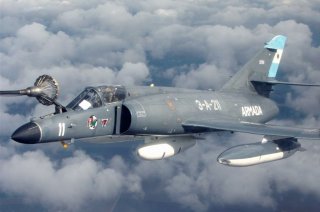A French Plane Brought Pain to Two British Ships in the Falklands War
The Super Étendard will always be remembered foremost for its role in sinking British two ships during the Falkland War
In case international alarm was insufficient, in 1983 Iraq leased five Super Étendards from France for use in the infamous Tanker War, in which Iran and Iraq did their best to sink each other’s petroleum transports. The Iraqi Étendards attacked more than thirty-four tankers with Exocets, typically fired from maximum range without confirming the identities of their targets. Fortunately, the medium-sized missile lacked the punch to easily sink massive seagoing tankers. Iran claimed it shot down three of the maritime marauders, but in fact all but one of the Super Étendards were returned to France once Iraq acquired Mirage F.1 fighters that could launch Exocet missiles.
The Étendard in French Service
The Étendard also gave decades of reliable service in combat to the French Navy, with sixteen each serving in the carrier air wings of the Foch and Clemenceau, and later the Charles de Gaulle. The attack planes were upgraded to carry AN-52 nuclear gravity bombs during the eighties, as part of the French deterrence force, later upgraded to the supersonic ASMP missile, which has a range of sixty miles and can carry a hundred-kiloton nuclear warhead.
Eight of the strike planes first saw action in French service in 1983, hitting Syrian artillery positions in Lebanon which had opened fire on French troops, followed by a second strike on an Islamic Amal terrorist training camp. They went on to fly 415 combat missions over Bosnia and Serbia during the 1990s, making increasing use of laser-guided bombs. The type was commended for its high operational readiness and accurate delivery of precision-guided weapons in combat missions over Kosovo, where the Super Étendard scored its only aerial victory: an Mi-8 Hip transport helicopter shot down by cannon fire.
Following the 9/11 attacks, Super Étendard planes flew reconnaissance and close air support missions over Afghanistan for nearly a decade, even as they were gradually replaced by far more capable Rafale-M multirole fighters. The carrier-based aircraft needed to refuel four times in flight to accomplish the three-thousand-mile round trips to the Afghan war zone.
The Étendard was also active in the French intervention against Qaddafi in 2011 and the war against ISIS in Iraq in 2015. An Étendard catapulted from the flight deck of the Charles de Gaulle for the last time on March 16, 2016, before the plane was finally retired from French service.
Upgraded Étendards for Argentina
France gradually began instituting a series of modernization measures for the Super Étendard known as SEM. These started with new Anemone radars boasting twice the range of the Agave system, and ATLIS and DAMOCLES laser-targeting pods. By 2002, the SEM4 upgrade added an advanced automated countermeasure system including chaff dispensers, Barracuda jammers, ECM pods and an improved Radar Warning Receiver, as well as new panoramic lens reconnaissance pods. Finally SEM5 brought in GPS navigation and a new PCN90 flight computer.
In 2009, France agreed to upgrade the Argentine’s Étendard fleet. Argentina still operates ten or eleven Super Étendards—one of them is a museum—having received the rest of its initial order after the Falkland War. However, it no longer has a carrier from which to launch them. For a while, Argentine pilots still practiced carrier operations onboard the Brazilian carrier Sao Paolo (the former French carrier Clemenceau), but this has been decommissioned as of February of this year.
For years, the upgrade process languished, possibly due to British pressure. Though the days of the military junta are long gone, the Argentine government still maintains its right to the disputed islands. However, press reports this week appear to signal that Argentina will be accepting a French offer of six upgraded Super Étendards retired from French service. The naval attack plane may have flown its last mission for France, but it looks set to serve many more years in the South American country where it made its reputation.
Sébastien Roblin holds a master’s degree in conflict resolution from Georgetown University and served as a university instructor for the Peace Corps in China. He has also worked in education, editing and refugee resettlement in France and the United States. He currently writes on security and military history for War Is Boring. This article is being republished due to reader interest.
Image: Wikipedia.

